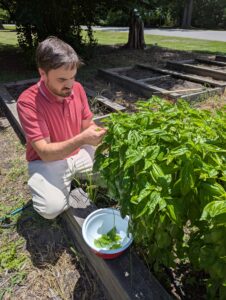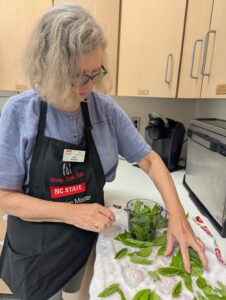Basil and Pesto
go.ncsu.edu/readext?1081950
en Español / em Português
El inglés es el idioma de control de esta página. En la medida en que haya algún conflicto entre la traducción al inglés y la traducción, el inglés prevalece.
Al hacer clic en el enlace de traducción se activa un servicio de traducción gratuito para convertir la página al español. Al igual que con cualquier traducción por Internet, la conversión no es sensible al contexto y puede que no traduzca el texto en su significado original. NC State Extension no garantiza la exactitud del texto traducido. Por favor, tenga en cuenta que algunas aplicaciones y/o servicios pueden no funcionar como se espera cuando se traducen.
Português
Inglês é o idioma de controle desta página. Na medida que haja algum conflito entre o texto original em Inglês e a tradução, o Inglês prevalece.
Ao clicar no link de tradução, um serviço gratuito de tradução será ativado para converter a página para o Português. Como em qualquer tradução pela internet, a conversão não é sensivel ao contexto e pode não ocorrer a tradução para o significado orginal. O serviço de Extensão da Carolina do Norte (NC State Extension) não garante a exatidão do texto traduzido. Por favor, observe que algumas funções ou serviços podem não funcionar como esperado após a tradução.
English
English is the controlling language of this page. To the extent there is any conflict between the English text and the translation, English controls.
Clicking on the translation link activates a free translation service to convert the page to Spanish. As with any Internet translation, the conversion is not context-sensitive and may not translate the text to its original meaning. NC State Extension does not guarantee the accuracy of the translated text. Please note that some applications and/or services may not function as expected when translated.
Collapse ▲

The fabulous basil planted at our N.C. Cooperative Extension Office was ready to be harvested. Our Extension Master Food Volunteers jumped in and made pesto.
Basil is a fairly easy to grow garden herb. You don’t need a garden or a raised bed, it’s perfectly happy in a container on a deck or porch. Basil does need a sunny location and a constant supply of moisture. It should be harvested several times during the growing season. The more you harvest the more you get. According to the Clemson Cooperative Extension Home and Garden Information Center, to create thicker plants with more tender foliage for harvest, the terminal growth of basil plants should be pinched out periodically. For the most flavorful leaves, when flower spikes or buds need to be pinched out as soon as possible as basil tends to become bitter once these flowers bloom. With the extremely hot weather we’ve been experiencing basil tends to bloom more often. Basil is a tender annual and will not survive the winter, so enjoy it now.
It is a tender herb and needs to be handled carefully. Basil blackens and bruises very easily when cut. If you have a bunch you’re trying to keep, place in a glass of water (like you would a bouquet of flowers) and store on the counter top (not in the refrigerator).
Pesto is easy to make and a great way use and preserve this herb. Use this recipe as a starting point for ingredients and the amounts needed. You can adjust based on your flavor preferences.
Basil Pesto
- 2 cups basil leaves, packed
- 2-3 cloves garlic
- 1/ 4-1/3 cup pine nuts
- ½ cup olive oil (may need a little more)
- ½ cup Parmesan or Romano cheese grated or shredded (about 2 ounces)
- Salt (to taste)
Rinse the basil leaves thoroughly and pat them dry. In a food processor, combine basil, garlic, and nuts. Pulse until finely chopped. With the processor running, slowly drizzle in the olive oil until the mixture is smooth. Add the cheese and pulse until combined. Adjust seasoning with salt. Transfer pesto to a jar and cover with a thin layer of olive oil to preserve freshness. Refrigerate for up to 3 days. Makes approximately 2 ½ cups pesto.
A food processor is the ideal appliance to use when making pesto. The EMFVs used a blender and it did take some extra work and some extra olive oil incorporating all the ingredients. If you don’t have either, you could use a mortar and pestle or finely chop and mash ingredients. Start with the garlic and salt, then add nuts and basil and stir in oil and grated cheese at the end.
Pesto is one of those recipes where you can experiment and change based on your preferences. Traditionally, pesto is made with pine nuts, but they can be pricey. You substitute other nuts such as cashews, almonds, pecans or walnuts as you like or have on hand. For more flavor, toast the nuts before adding.
Basil is the traditional ingredient in this pesto, but other herbs or leafy greens such parsley, kale, spinach or even carrot tops could be substituted for all or part of it. Lemon juice and lemon zest can be added for a unique flavor. For a spicier pesto, try adding a dash of black pepper or red pepper flakes.
Pesto is frequently used as a sauce for pasta, but it can be a topping on grilled or roasted meat, fish or poultry. Try mixing with mashed avocado, mayonnaise or tahini for a creamy dip, sauce, spread or dressing. Or add to scrambled eggs, omelets, quiche and frittatas or to season sauces and soups.
We made over 14 cups of pesto, so needed a way to preserve it. According to the National Center for Home Food Preservation (NCHFP) there is not a research tested recipe for canning pesto. But it may be frozen for long term storage. Package in glass freezer jars or plastic freezer boxes, leaving 1/2-inch headspace. Label and freeze. To use frozen pesto, thaw in refrigerator or defrost in microwave. Don’t allow pesto to overheat in microwave, as it should not cook.
Additional Resources
Syracuse is a Family and Consumer Science team member and can be reached at N.C. Cooperative Extension, Brunswick County Center 910-253-2610 or by email at clsyracu@ncsu.edu



